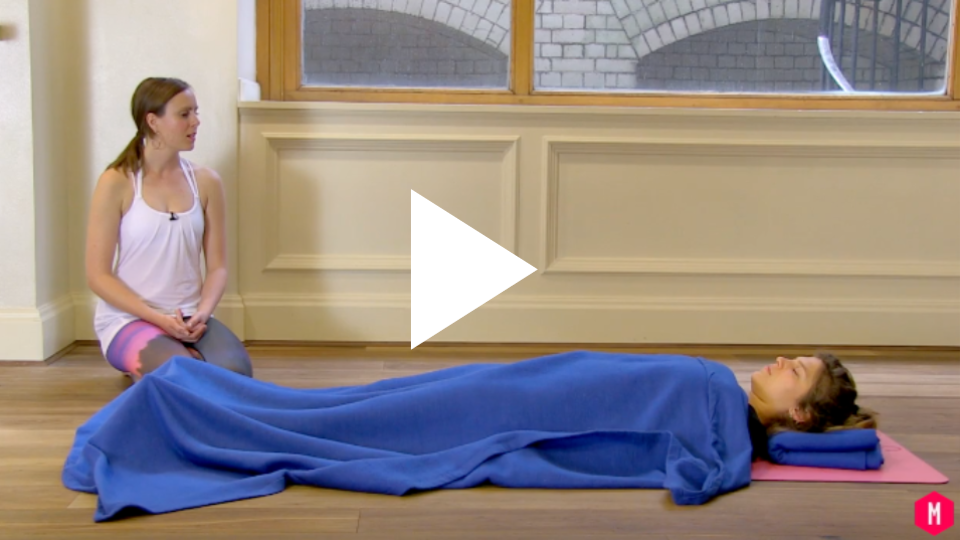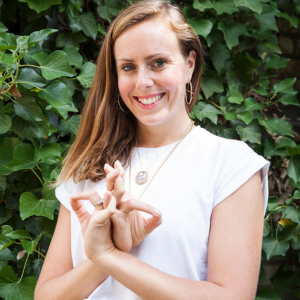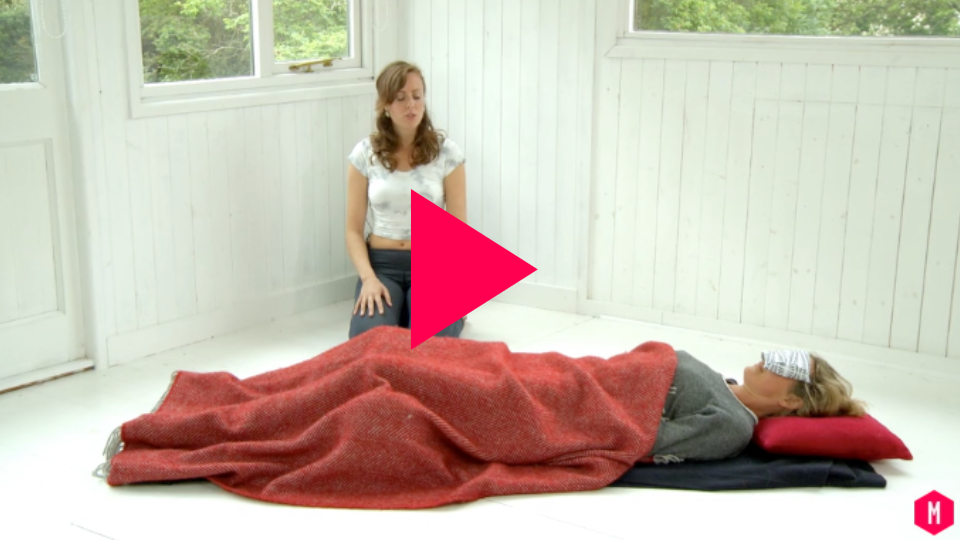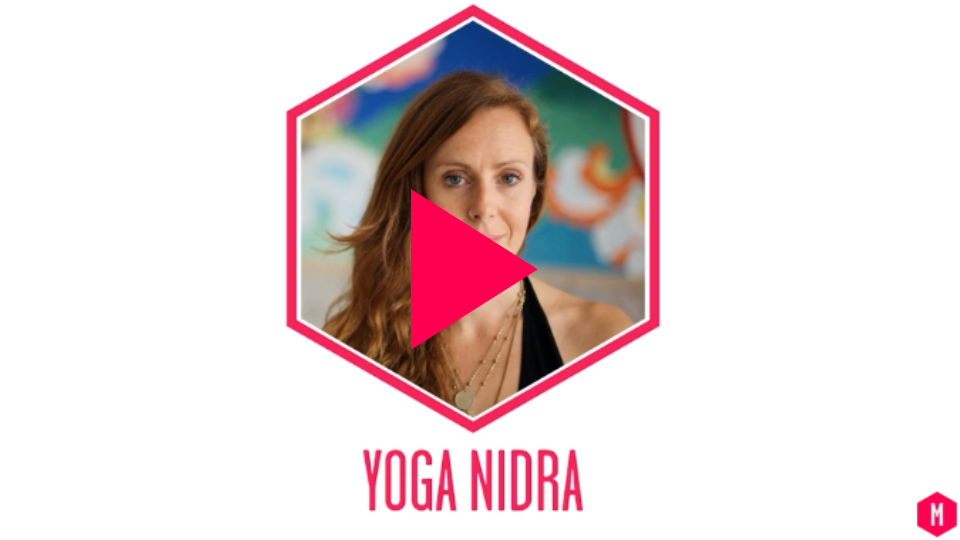
Yoga Nidra is a yogic practice that has risen in popularity and renown recently.
And rightly so as this is a profound ancient practice that has many benefits ranging from spiritual awakening to supporting us with reprogramming old, unhelpful belief systems. Simply put, Yoga Nidra for sleep and anxiety is a wonderful resource for helping us when we need it most.
Read more about yoga for stress and anxiety in this complete guide
Before we dive into the why and how of practising Yoga Nidra for sleep and anxiety, let’s talk about what Yoga Nidra actually is….
So it is made up of the words ‘yoga’ and ‘nidra’…. and I always find it helpful to break down the meaning and etymology of Sanskrit (the ancient language of India) words in order to better understand the practice and its roots.
The word ‘yoga’ comes from the Sanskrit root ‘yuj’ meaning to yoke or come together, often defined as a state of union. The word ‘nidra’ means ‘sleep.’
Yoga Nidra is essentially a state that mimics physiological sleep, in which a quality of union and in fact, awakening can be had.
Though it has the word ‘sleep’ in it, Yoga Nidra is not actually a practice involving sleep per se, rather a practice that induces yogic sleep which is very different to our regular nightly sleep.
In yogic sleep, the physical body is induced into such a deep state of relaxation it mimics sleep but the conscious mind is invited to stay present.
Interestingly enough, in our regular night’s sleep, we can often maintain and hold onto physical tension. This can result in us waking up still feeling fatigued, despite having had a good amount of hours sleeping.
Whereas, in Yoga Nidra, we are consciously guided to release all physical tension, which often results in us finishing our Yoga Nidra practice feeling revived, energised and rested in a way that often evades us after a night’s sleep. Magic right?!

What is involved in Yoga Nidra?
Yoga Nidra is usually a laying down practice in which the practitioner is guided into a liminal state between waking and sleep. A state very similar to what happens just as you are waking up or going to sleep.
In this potent liminal state, a profound bodily relaxation arises which is part of the puzzle of why Yoga Nidra can actually help with sleep and anxiety issues.
Sleep issues and anxiety have a lot in common.
An inability to relax deeply, tension in the physical body and a whirring, busy mind that won’t allow us to rest in a state of ease, let alone drop into sweet, undisturbed sleep are just a few similarities.
Both sleep issues and anxiety often belie a disordered nervous system that spends a disproportionate amount of time in the stress response (the sympathetic branch of nervous system) rather than the relaxation response (the parasympathetic branch of the nervous system).
One of the wonders of a Yoga Nidra practice is that we are guided through various methods into a profound state of mental and physical relaxation.
Check out Lucy McCarthy’s Yoga Nidra Elements Audio Series:
What is the Rotation of Consciousness?
A primary tool used in Yoga Nidra is known as the ‘Rotation of Consciousness’ through the body.
This is derived from an ancient tantric practice, known as Nyasa, in which our awareness is taken in a systematic way around various points of the physical body.
Rotation of Consciousness is said to be a way of divinising the body, bringing a remembrance of the body’s innate goodness and beauty back into the practitioner’s awareness.
Modern Yoga Nidra uses this rotation of body consciousness to induce deep relaxation in the skeletal-muscular system as well as bring a quality of quiet and stillness to the mind.
When we are anxious or unable to sleep at night, often one the hallmarks is the unceasing busyness and chatter of the mind. When the mind is taken by the hand and systematically guided around the body during a Yoga Nidra practice, what magically happens is the chatter begins to settle and a quieter state of mind arises.
This is one of the main keys to why Yoga Nidra can be so beneficial for sleep and anxiety.
Yoga Nidra can change our brain waves.
In our day to day waking existence, we spent most of our time in what’s known as the beta brain wave frequency.
At the lower end of beta frequencies we can be happily, moving through our day in a calm but alert manner. Anytime we feel overwhelmed, and it goes into the higher beta frequencies, stress often arises.
This stress is what is often associated with sleep and anxiety issues.
In the beta state, our main occupation is with our body, the environment we are in and the passing of time. How many of us can admit that our relationship with our body, our outer environment and our relationship with time are often at the root of a feeling of stress or strain?
Flow into an alpha brain wave frequency.
When we move through a Yoga Nidra practice, our brain waves begin to flow at a lower frequency known as the alpha brain wave frequency.
Alpha brainwaves are often present at that drowsy, just waking or just falling asleep phase of our day. They are also associated with meditative and mindful states of mind, which facilitate us feeling more relaxed and less anxious.
As we move from beta into alpha dominance, our preoccupation shifts away from our body, environment or sense of time and with that comes great relief.
Our identity then becomes more connected to this liminal space where we no longer feel harried by time, no longer so reactive to our outer environment and no longer preoccupied with our body.
Removing ourselves from these preoccupations is partly why we feel so revived after spending time in the alpha state. This is also why spending time in the alpha state, through our Yoga Nidra practice, is so supportive for sleep and anxiety issues.
The more time we can spend in Yoga Nidra, the more sophisticated the body and mind become at dropping into the alpha state and surfing that liminal space between waking and sleeping.
Tap Into the Magic of Yoga Nidra
In my own early postnatal days, when I was very sleep-deprived with a newborn, my daily Yoga Nidra practice became an essential way to rest and restore my low energy reserves.
Anytime in my life when I feel overwhelmed, anxious or exhausted, it is to my Yoga Nidra practice I turn to find solace and salvation!
So give it a go! Lay down, get cosy and allow the practice to work its magic and offer your mind, body and spirit its deep medicine.
Read more in Yoga for Stress and Anxiety: A Complete Guide

Lucy accidentally began her Yoga journey while on tour in India. What she loved most was the clarity and calm in her mind after class and how light and bright her body felt. Since that day she has continued to follow her passion finding her teachers along the path and immersing herself deeply in all things yoga. Lucy teaches mindful, heart felt Vinyasa flow, as well as Yoga Nidra and restorative yoga.












Leave a Reply